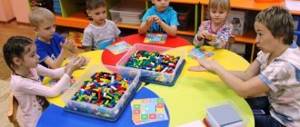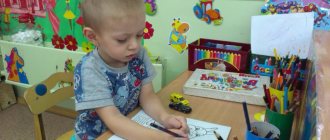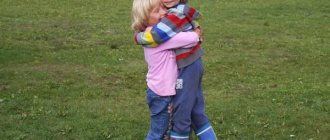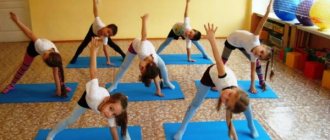The project method in preschool educational institutions as an innovative pedagogical technology
Bibliographic description:
Kasyanova, A. N. Project method in preschool educational institutions as an innovative pedagogical technology / A. N. Kasyanova. — Text: direct // Innovative pedagogical technologies: materials of the IV International. scientific conf. (Kazan, May 2020). — Kazan: Buk, 2020. — pp. 210-213. — URL: https://moluch.ru/conf/ped/archive/190/10387/ (date of access: 10.10.2020).
Knowledge is only knowledge when it is acquired through the efforts of one’s thoughts, and not through memory.
L. N. Tolstoy
From birth, a child is a discoverer, an explorer of the world that surrounds him. Everything is new for him: sun and rain, fear and joy. Everyone knows that five-year-old children are called “why kids.” A child cannot find the answer to all his questions on his own; teachers help him. Today, in science and practice, the view of the child as a self-developing system is intensively defended, while the efforts of adults should be aimed at creating conditions for the self-development of children.
A unique means of ensuring cooperation, co-creation between children and adults, and a way to implement a person-centered approach to education is design technology.
What is a project? The project is:
- a method of pedagogically organized development of the environment by a child in the process of step-by-step and pre-planned practical activities to achieve the intended goals.
- independent and collective creative completed work that has a socially significant result.
- a set of actions specially organized by the teacher and independently carried out by the pupils, aimed at resolving a problem situation and culminating in the creation of a creative product.
What is the project method? It has many different definitions, but in general it is a pedagogical technology, the core of which is the independent activity of children - research, cognitive, productive, during which the child learns about the world around him and translates new knowledge into real products.
Modern pedagogical research shows that the main problem of preschool education is the loss of liveliness and attractiveness of the learning process. The number of preschoolers who do not want to go to school is increasing; Positive motivation for classes has decreased, and children’s academic performance is falling.
How to improve the situation? The formation of a new education system, focused on entering the global space, requires significant changes in the pedagogical theory and practice of preschool institutions, and the improvement of pedagogical technologies.
The objectives of pedagogical activity are to educate a person who is able to integrate into society, behave positively in it, think independently, acquire and apply knowledge (and not just memorize and reproduce it), carefully consider the decisions made, and clearly plan their actions.
The implementation of these tasks is associated with the formation of a teacher who is able to work with a child for results, develop his communication skills and abilities, move away from authoritarianism in the organization of the educational process, and develop the desire for independent mental activity.
Today, any preschool institution, in accordance with the principle of variability, has the right to choose its own model of education and design the pedagogical process based on adequate ideas and technologies. Traditional education is being replaced by productive learning, which is aimed at developing creative abilities, developing preschoolers' interest and need for active creative activity.
The teaching staff of our preschool institution considers the method of pedagogical design as one of the effective means of solving these problems as one of the forms of planning and organizing work that influences the formation of the competence of teachers, the development of their research skills, the development of creativity, forecasting, the search for innovative means and, thus, improving the quality of the educational process.
The introduction of technology into practice - the project method - made it possible to change the style of working with children: increase children's independence, activity, curiosity, develop creative thinking in children, the ability to find a way out of a difficult situation, become more confident in their abilities, involve parents and other family members in educational preschool process.
Therefore, in the educational process of a preschool educational institution, project activities are in the nature of cooperation, in which children and teachers take part, and parents and other family members are also involved.
The project method can be adapted to all age groups; it is only necessary to take into account the psychological and physiological characteristics of children and understand the interests of preschoolers at this stage.
So, when working with children of primary preschool age, can a teacher use hints and leading questions? And children of older preschool age need to be given more independence.
Projects are classified according to different criteria.
The most significant is the dominant activity. The following types of projects are used in the practice of preschool educational institutions:
Research: a research search is carried out, the results of which are presented in the form of some kind of creative product (newspapers, dramatizations, card indexes of experiences, children's design, cookbook, etc.). They involve testing a certain assumption (hypothesis) using a method of cognition (observation, experiment), for example. “Why do children get sick?”, “What do we know about water”, “How do peas grow?”;
Role-playing games: this is a project with elements of creative games, when children take on the characters of a fairy tale and solve the problems in their own way. Such projects are based on role-playing games and children are actively involved in them. They willingly perform roles. For example, “My favorite toy”, “Visiting a fairy tale”;
Information-practice-oriented: children collect information about some object or phenomenon from various sources, and then implement it, focusing on social interests: designing a group, apartment, etc. For example, “Heroes-Countrymen”
Creative: as a rule, they do not have a detailed structure for the joint activities of the participants. The results are presented in the form of a children's party or exhibition. for example, “Concert for Mothers”, a performance for children;
Practical: associated with working to achieve a significant result. For example, landscaping a group, designing a flower bed and caring for it;
Other classification features are:
Composition of participants (group, subgroup, personal, family, pair, etc.)
Duration (short-term - several sessions, 1-2 weeks, medium duration - 1-3 months, long-term - up to 1 year)
The tasks of research activities are specific for each age.
In early preschool age this is:
‒ children’s entry into a problematic play situation (the leading role of the teacher);
‒ intensifying the desire to look for ways to solve a problem situation (together with the teacher);
‒ formation of initial prerequisites for research activities (practical experiments).
In older preschool age this is:
‒ formation of prerequisites for search activity and intellectual initiative;
‒ developing the ability to identify possible methods of solving a problem with the help of an adult, and then independently.
Stages of work on the project:
Stage I of project development - goal setting: the teacher brings the problem to the children for discussion.
Stage II of the project is the development of a joint action plan to achieve the goal. First, a general discussion is held so that the children find out what they already know about a certain subject or phenomenon. The teacher records the answers on a large piece of Whatman paper so that the group can see them. To record answers, it is better to use conventional schematic symbols that are familiar and accessible to children. Then the teacher asks the second question: “What do we want to know?” The answers are again recorded, regardless of the fact that they may seem stupid or illogical. It is important here that the teacher shows patience, respect for the point of view of each child, and tactfulness in relation to the ridiculous statements of the kids. When all the children have spoken, the teacher asks: “How can we find answers to the questions?” When answering this question, children rely on their personal experience.
The solution to this question can be various activities: reading books, encyclopedias, contacting parents, specialists, conducting experiments, thematic excursions.
After drawing up a joint action plan, the third stage of work on the project begins - its practical part. Children explore, experiment, search, create. To activate children's thinking, the teacher offers to solve problem situations and puzzles, thereby developing an inquisitive mind. It is necessary that the teacher be able to create a situation where the child must learn something on his own, guess, try, invent something. The environment around the child should be, as it were, unfinished, unfinished. A special role in this case is played by corners on cognitive and practical activities.
The final, IV stage of work on the project is the presentation of the project. The presentation can take place in various forms depending on the age of the children and the theme of the project: final games-activities, quiz games, themed entertainment, design of albums, photo exhibitions, mini-museums, creative newspapers.
The specificity of using the project method in preschool practice is that adults need to “guide” the child, help detect a problem or even provoke its occurrence, arouse interest in it and “draw” children into a joint project, without overdoing it with parental care and help. The teacher acts as an organizer of children's productive activities, he is a source of information, a consultant, an expert. He is the main leader of the project and subsequent research, gaming, artistic, practice-oriented activities, the coordinator of individual and group efforts of children in solving the problem. In this case, the adult acts as a partner for the child and an assistant in his self-development.
In practice, there are several methods for developing projects.
- "Three Question Model"
- Mind Mapping Method (Tony Buzan)
Consider the Three Question Model. The essence of this model is that the teacher asks the children three questions:
‒ What do we know?
‒ What do we want to know?
- How will we know about this?
The teacher initiates a general discussion so that the children find out what they already know about a certain subject or phenomenon. As the children answer the question, the teacher writes their answers on a large piece of paper for the group to see. You need to write down the answers of all the children and indicate their names next to them. Then the teacher asks the question: “What do we want to learn about?” Children's answers determine the tasks and directions of cognitive activity. When all the children have spoken, the teacher asks: “How can we find answers to our questions?” You can use symbols to collect information in pictures.
The second method is the “Mind Map” method, this is a convenient and effective technique for visualizing thinking and alternative recording. These are your thoughts expressed on paper graphically. The founder of this technique is an American specialist in intelligence, learning psychology and thinking problems, Tony Buzan.
Mental maps help to identify existing knowledge and ideas in children, organize them, then add and classify new ones, and then organically connect them with each other.
A mental map is drawn up in the form of a tree diagram, on which ideas, tasks, and problems are indicated by words. It is an associative network consisting of images and words.
In the center of the sheet we place the main topic, that is, we write a word or execute it in the form of a picture. For example, the theme is fruits, you can draw a basket or other image associated with fruits.
Next, the child draws thick branches to the corners of the sheet, each with its own color. Above each branch the teacher writes the word association. The child adds each word with a picture or drawing that represents the word.
Then we work with each branch in turn. From the main branch we draw several branches, depending on the emerging images and associations. For example, we associate the word apple with the color green, the next branch is a saying. Next, from this second-order branch, we draw a third-order branch, for example, the above saying can be associated with health, vitamins, etc. It is also advisable to depict these words in the form of drawings, for better memorization by children.
When work with one branch is completed, we move on to the next and so on with each in turn. If, while working on any branch, ideas arise about another, then they need to be written down.
Thanks to these models, the teacher receives primary information about the stock of knowledge, children’s ideas on the topic, orients himself and helps orient children in ways of obtaining and clarifying knowledge, children participate in the general planning of upcoming cognitive activities.
The knowledge acquired by children during projects is successfully applied in everyday life and in routine situations.
Using the project method in working with preschoolers helps to increase the child’s self-esteem. By participating in the project, the child feels significant in a group of peers, sees his contribution to the common cause, and rejoices in his successes. The project method promotes the development of favorable interpersonal relationships in a group of children.
The project method can go through all types of children's activities in preschool educational institutions. Encourages teachers to improve their professional and creative level, which undoubtedly affects the quality of the educational process. Encourages active interaction between all preschool specialists, parents of pupils and social organizations. Forms in preschoolers the ability to plan and independence in solving a given problem, promotes the development of cognitive and creative activity.
Thus, the project method can be considered as a special mechanism for interaction between the family and the preschool educational institution. Parents can not only be sources of information, real help and support for the teacher while working on the project, but also become direct participants in the educational process, experience a sense of ownership and satisfaction from their successes and the successes of their children.
Literature:
- Veraksa N. E., Veraksa A. N. Project activities of preschoolers. A manual for teachers of preschool institutions. - M.: Mozaika - Synthesis, 2008. - 112 p.
- Educational projects in kindergarten. Manual for educators/N. A. Vinogradova, E. P. Pankova. - M.: Iris-press, 2008. - 208 p. — (Preschool education and development).
- Project method in the activities of preschool institutions: A manual for managers and practical workers of preschool educational institutions / Author: L. S. Kiseleva, T. A. Danilina, T. S. Lagoda, M. B. Zuikova. — 3rd ed. pspr. and additional - M.: ARKTI, 2005. - 96 p.
- Problems of preschool education at the present stage: Issue 5. / Comp. O. V. Dybina, O. A. Yenik. - Tolyatti: TSU, 2007. - 116 p.
- Shtanko I.V. Project activities with children of senior preschool age. // Management of a preschool educational institution. 2004, No. 4.
Key terms
(automatically generated)
: child, teacher, educational process, project, preschool institution, project method, stage of work, research activity, junior preschool age, general discussion.







